The Srebrenica Massacre - Nova Srpska Politicka Misao
The Srebrenica Massacre - Nova Srpska Politicka Misao
The Srebrenica Massacre - Nova Srpska Politicka Misao
Create successful ePaper yourself
Turn your PDF publications into a flip-book with our unique Google optimized e-Paper software.
<strong>The</strong> Military Context of the Fall of <strong>Srebrenica</strong><br />
one fatally. <strong>The</strong> cry that “Something must be done!” was deafening.<br />
<strong>The</strong>n on December 14, both Radovan Karadzic and the former U.S.<br />
President Jimmy Carter appeared via telephone on consecutive segments<br />
of the CNN nightly news. Karadzic declared that Carter had agreed to<br />
help in negotiating a comprehensive peace settlement for Bosnia, and<br />
would shortly be travelling there. As a demonstration of the Bosnian<br />
Serbs’ readiness to negotiate, Karadzic announced a series of unilateral<br />
concessions by the Bosnian Serbs effective within 24 hours. 15<br />
This took observers by surprise, but within days the Clinton White<br />
House was busy issuing statements minimising the impact of the initiative<br />
and even casting aspersions on Carter’s grasp of the situation.<br />
Even by the standards of the Balkans, it was an extraordinary situation<br />
in which a former Democratic U.S. President was putting his prestige<br />
and reputation behind a peace plan that at the same time was being undermined<br />
by the incumbent Democratic U.S. President. It later transpired<br />
that the irony was even darker: <strong>The</strong> Clinton administration was<br />
allowing a flood of arms to the SDA Muslims from Iran, the very country<br />
which had humiliated the United States during Carter’s term in office<br />
by holding its embassy staff hostage for 444 days.<br />
Nevertheless, discussions went ahead under Jimmy Carter’s chairmanship<br />
and, on his departure from Bosnia, he announced a “complete<br />
ceasefire throughout Bosnia to be implemented on December 23.” 16 Although<br />
not party to the Cessation of Hostilities Agreement (COHA),<br />
as the Carter Agreement was formally known, but in its spirit, the Krajina<br />
Serbs removed road blocks allowing the main Zagreb to Belgrade<br />
highway to reopen on December 21. By the same date, the BSA 5th<br />
Corps had withdrawn from Velika Kladusa in the Bihac pocket allowing<br />
Abdic to reoccupy his headquarters, albeit stripped of almost everything.<br />
O’Shea describes the implementation of the agreement as follows:<br />
[All] sides initially appeared to be committed to the process,<br />
notwithstanding yet another attack on Sarajevo’s market place<br />
in which two men died. Not for the first time there was no clear<br />
indication from where the shells had been fired but it is not unreasonable<br />
to suggest that whoever ordered the attack did so in<br />
the hope of scuttling the Carter Agreement, as well as exerting<br />
some influence on Akashi. He was at that very moment deep in<br />
73



